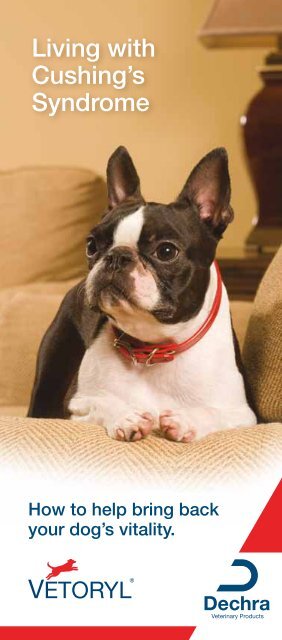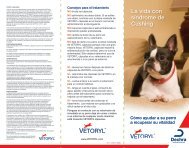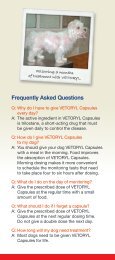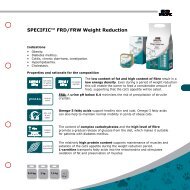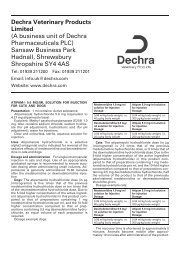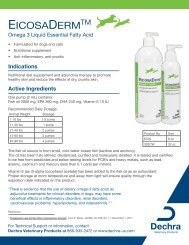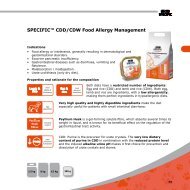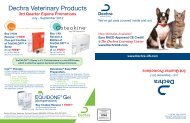Vetoryl - Dechra-US.com
Vetoryl - Dechra-US.com
Vetoryl - Dechra-US.com
Create successful ePaper yourself
Turn your PDF publications into a flip-book with our unique Google optimized e-Paper software.
Living with<br />
Cushing’s<br />
Syndrome<br />
How to help bring back<br />
your dog’s vitality.
RYL ® CAPSULES<br />
e)<br />
l suppressant for oral use in dogs only.<br />
What is<br />
Cushing’s<br />
Syndrome?<br />
law restricts this drug to use by or on the order of a licensed veterinarian.<br />
DESCRIPTION:<br />
VETORYL Capsules are available in 4 sizes (10, 30, 60 and 120 mg) for oral administration based on body<br />
weight. Trilostane (4a, 5a-epoxy-17ß-hydroxy-3-oxoandrostane-2a-carbonitrile) is an orally active synthetic<br />
steroid analogue that selectively inhibits 3 ß-hydroxysteroid dehydrogenase in the adrenal cortex, thereby<br />
inhibiting the conversion of pregnenolone to progesterone. This inhibition blocks production of<br />
glucocorticoids and to a lesser extent, mineralocorticoids and sex hormones while steroid precursor levels<br />
increase. The structural formula is:<br />
Cushing’s syndrome is one of the most<br />
<strong>com</strong>monly diagnosed canine endocrine<br />
disorders. Dogs with this disease produce<br />
excessive amounts of cortisol, a hormone<br />
that normally helps the body respond to<br />
stress. Overproduction of cortisol can have<br />
harmful effects on your dog’s internal organs<br />
and can diminish health and vitality.<br />
Cushing’s syndrome Action is usually caused by<br />
a tumor of either the pituitary gland or the<br />
adrenal EITHER: glands.<br />
Continue on current dose if clinical signs are well controlled<br />
OR: Increase dose if clinical signs of hyperadrenocorticism are still evident*<br />
Pituitary gland tumors account for 80-85%<br />
of Cushing’s syndrome cases. These tumors<br />
cause the pituitary gland to produce large<br />
amounts of the hormone ACTH, which<br />
stimulates the adrenal gland to overproduce<br />
cortisol. Malignant tumors of the pituitary<br />
gland are rare.<br />
Adrenal gland tumors account for 15-20%<br />
of Cushing’s syndrome cases. These<br />
tumors, which can occur in either one<br />
or both adrenal glands, cause production<br />
of excessive amounts of cortisol. Surgical<br />
removal of the affected gland is sometimes<br />
re<strong>com</strong>mended in these cases. Benign<br />
and malignant adrenal tumors occur<br />
with equal frequency.<br />
:<br />
sules are indicated for the treatment of pituitary-dependent hyperadrenocorticism in dogs.<br />
sules are indicated for the treatment of hyperadrenocorticism due to adrenocortical tumor in dogs.<br />
ADMINISTRATION:<br />
the Client Information Sheet with prescription.<br />
se for the treatment of hyperadrenocorticism in dogs is 1.0-3.0 mg/lb (2.2-6.7 mg/kg) once a day based on<br />
nd capsule size (see Table 1). VETORYL Capsules should be administered with food.<br />
ng dose<br />
t range (pounds) Weight range (kg) Starting dose (mg) ONCE DAILY<br />
3.8 to < 10 ≥ 1.7 to < 4.5 10<br />
10 to < 22 ≥ 4.5 to < 10 30<br />
22 to < 44 ≥ 10 to < 20 60<br />
44 to < 88 ≥ 20 to < 40 120<br />
88 to < 132* ≥ 40 to < 60* 180 (1 x 120 mg and 1 x 60 mg)<br />
pounds (60 kg) should be administered the appropriate <strong>com</strong>bination of capsules.<br />
ately 10-14 days at this dose, re-examine the dog and conduct a 4-6 hour post-dosing ACTH stimulation<br />
l examination is acceptable, take action according to Table 2.<br />
n at 10-14 day evaluation<br />
H serum cortisol<br />
nmol/L<br />
< 40 Stop treatment. Re-start at a decreased dose<br />
40 to 150 Continue on same dose<br />
1 > 150 to 250<br />
> 250 Increase initial dose<br />
f capsule sizes should be used to slowly increase the once daily dose.<br />
e adjustments and close monitoring are essential. Re-examine and conduct an ACTH stimulation test<br />
er every dose alteration. Care must be taken during dose increases to monitor the dog’s clinical signs and<br />
yte concentrations. Once daily administration is re<strong>com</strong>mended. However, if clinical signs are not controlled<br />
twice daily dosing may be needed. To switch from once daily to twice daily dosing, increase the total daily<br />
1/2 and divide the total amount into two doses given 12 hours apart.<br />
nitoring<br />
um dose of VETORYL Capsules has been reached, re-examine the dog at 30 days, 90 days and every 3 months<br />
minimum, this monitoring should include a thorough history and physical examination, ACTH stimulation test<br />
hours after VETORYL Capsule administration), and serum biochemical tests (with particular attention to<br />
nal and hepatic function). A post-ACTH stimulation test resulting in a cortisol of < 1.45 µg/dL (< 40 nmol/L),<br />
electrolyte abnormalities, may precede the development of clinical signs of hypoadrenocorticism. Good<br />
ated by favorable clinical signs as well as post-ACTH serum cortisol of 1.45-9.1 µg/dL (40-250 nmol/L).<br />
mulation test is < 1.45 µg/dL (< 40 nmol/L) and/or if electrolyte imbalances characteristic of hypoadrenocorticism<br />
and hyponatremia) are found, VETORYL Capsules should be temporarily discontinued until recurrence of clinical<br />
t with hyperadrenocorticism and test results return to normal (1.45-9.1 µg/dL or 40-250 nmol/L). VETORYL<br />
then be re-introduced at a lower dose.<br />
be instructed to stop therapy and contact their veterinarian immediately in the event of adverse reactions or<br />
pments.<br />
CATIONS:<br />
ORYL Capsules is contraindicated in dogs that have demonstrated hypersensitivity to trilostane.<br />
TORYL Capsules in animals with primary hepatic disease or renal insufficiency.<br />
regnant dogs. Studies conducted with trilostane in laboratory animals have shown teratogenic effects and<br />
y loss.<br />
dosage, symptomatic treatment of hypoadrenocorticism with corticosteroids, mineralocorticoids and intravenous<br />
equired.<br />
nverting enzyme (ACE) inhibitors should be used with caution with VETORYL Capsules, as both drugs have<br />
wering effects which may be additive, impairing the patient's ability to maintain normal electrolytes, blood<br />
nal perfusion. Potassium sparing diuretics (e.g. spironolactone) should not be used with VETORYL Capsules<br />
have the potential to inhibit aldosterone, increasing the likelihood of hyperkalemia.<br />
NINGS:<br />
ach of children. Not for human use.<br />
ter use. Do not empty capsule contents and do not attempt to divide the capsules. Do not handle the capsules if<br />
ying to conceive. Trilostane is associated with teratogenic effects and early pregnancy loss in laboratory animals.<br />
accidental ingestion/overdose, seek medical advice immediately and take the labeled container with you.<br />
S:<br />
rticism can develop at any dose of VETORYL Capsules. In some cases, it may take months for adrenal function<br />
ome dogs never regain adequate adrenal function.<br />
tage of dogs may develop corticosteroid withdrawal syndrome within 10 days of starting treatment. This<br />
esults from acute withdrawal of circulating glucocorticoids; clinical signs include weakness, lethargy, anorexia,<br />
s 1 . These clinical signs should be differentiated from an early hypoadrenocortical crisis by measurement of<br />
te concentrations and performance of an ACTH stimulation test. Corticosteroid withdrawal syndrome should<br />
sation of VETORYL Capsules (duration of discontinuation based on the severity of the clinical signs) and<br />
ower dose.<br />
DDD) treatment will reduce adrenal function. Experience in foreign markets suggests that when mitotane therapy<br />
interval of at least one month should elapse before the introduction of VETORYL Capsules. It is important to<br />
e recurrence of clinical signs consistent with hyperadrenocorticism, and a post-ACTH cortisol level of > 9.1 µg/dL<br />
before treatment with VETORYL Capsules is initiated. Close monitoring of adrenal function is advised, as dogs<br />
ed with mitotane may be more responsive to the effects of VETORYL Capsules.<br />
ORYL Capsules will not affect the adrenal tumor itself. Adrenalectomy should be considered as an option<br />
are good surgical candidates.<br />
f this drug has not been evaluated in lactating dogs and males intended for breeding.
Diagnosing the Disease<br />
Some clinical signs of Cushing’s syndrome<br />
may initially be overlooked, because they mimic<br />
normal aging changes. Keep in mind that not all<br />
dogs will react to the disease in the same way<br />
or display all of these symptoms:<br />
• Increased water intake<br />
• Frequent urination<br />
• Muscle wasting/weakness<br />
• Lethargy<br />
• Ravenous appetite<br />
• Pot belly<br />
• Excessive panting<br />
• Hair loss<br />
• Recurring skin disease<br />
• Thin skin<br />
Due to the difficulty of accurately diagnosing<br />
Cushing’s syndrome, special blood tests are<br />
necessary to confirm the disease. Your dog may<br />
need to spend the day with your veterinarian<br />
to <strong>com</strong>plete these tests. An ultrasound<br />
examination may also be required, so that the<br />
veterinarian can differentiate between a pituitary<br />
tumor and an adrenal tumor.
The Importance of Treatment<br />
Cushing’s syndrome impacts the quality of life<br />
for both you and your dog.* If left untreated,<br />
Cushing’s syndrome increases your dog’s risk<br />
of developing serious conditions such as:<br />
• Diabetes<br />
• Blood clots in the lungs<br />
• Kidney infection<br />
• Urinary tract infection<br />
• Inflammation of the pancreas<br />
Managing Cushing’s Syndrome<br />
Cushing’s syndrome can be successfully<br />
managed and controlled through medication.<br />
VETORYL ® (trilostane) Capsules are the only<br />
licensed treatment for managing the clinical<br />
signs associated with both the pituitary gland<br />
and adrenal gland tumors that cause<br />
Cushing’s syndrome.<br />
With VETORYL Capsules, you and your<br />
veterinarian can effectively control the<br />
symptoms of Cushing’s syndrome and<br />
help your dog maintain a good quality of<br />
life for years to <strong>com</strong>e.<br />
The First Steps to Good Health<br />
The sooner you begin treatment of Cushing’s<br />
syndrome, the sooner your dog will begin<br />
to feel better.<br />
*Cook, AK. Trilostane: A therapeutic consideration for dogs with<br />
hyperadrenocorticism. Veterinary Medicine, February 2008.
Prior to VETORYL treatment<br />
Today<br />
Your veterinarian will re<strong>com</strong>mend a starting<br />
dose of VETORYL Capsules based on your<br />
dog’s body weight.<br />
In 2 weeks<br />
Your veterinarian will assess your dog’s<br />
response to VETORYL Capsule treatment by<br />
evaluating the clinical signs, performing blood<br />
tests, and possibly adjusting the dosage.<br />
In most cases, you can expect to see the<br />
following improvements within two weeks<br />
of starting therapy with VETORYL Capsules:<br />
• Decrease in appetite<br />
• Increase in energy<br />
• Decrease in water consumption<br />
• Decrease in frequency of urination<br />
At 4 and 12 weeks<br />
Your veterinarian will schedule appointments to<br />
continue monitoring the early stages of therapy<br />
and, if needed, adjust the dosage of VETORYL<br />
Capsules to meet your dog’s specific needs.<br />
Every 3 months<br />
Once your veterinarian is satisfied with your<br />
dog’s progress, office visits are generally only<br />
necessary once every three months. However,<br />
your veterinarian will need to see your dog<br />
sooner if any illness arises or if the signs of<br />
Cushing’s syndrome recur.
Following 3 months<br />
of treatment with VETORYL<br />
Frequently Asked Questions<br />
Q: Why do I have to give VETORYL Capsules<br />
every day?<br />
A: The active ingredient in VETORYL Capsules<br />
is trilostane, a short-acting drug that must<br />
be given daily to control the disease.<br />
Q: How do I give VETORYL Capsules<br />
to my dog?<br />
A: You should give your dog VETORYL Capsules<br />
with a meal in the morning. Food improves<br />
the absorption of VETORYL Capsules.<br />
Morning dosing makes it more convenient<br />
to schedule the monitoring tests that need<br />
to take place four to six hours after dosing.<br />
Q: What do I do on the day of monitoring?<br />
A: Give the prescribed dose of VETORYL<br />
Capsules at the regular time with a small<br />
amount of food.<br />
Q: What should I do if I forget a capsule?<br />
A: Give the prescribed dose of VETORYL<br />
Capsules at the next regular dosing time.<br />
Do not give a double dose the next day.<br />
Q: How long will my dog need treatment?<br />
A: Most dogs need to be given VETORYL<br />
Capsules for life.
Q: How long will it take my dog to improve after<br />
beginning treatment with VETORYL Capsules?<br />
A: Clinical signs such as lethargy or increased<br />
drinking, eating, and urination often improve<br />
within the first two weeks of treatment. Skin<br />
changes and hair regrowth may take three<br />
to six months to improve.<br />
Q: Will I need to revisit my veterinarian?<br />
A: Yes. It is important for your veterinarian to<br />
supervise your dog’s progress and monitor<br />
the dosage of VETORYL Capsules. Evaluations<br />
should be performed at 2 weeks, 4 weeks,<br />
and 12 weeks after starting treatment. Once<br />
on the maintenance dose, your dog should<br />
be evaluated by your veterinarian every<br />
three months.<br />
Q: Do VETORYL Capsules have any side effects?<br />
A: VETORYL Capsules are well tolerated by<br />
most dogs. If your dog develops any sign<br />
of illness while on VETORYL Capsules –<br />
particularly lethargy, vomiting, diarrhea,<br />
or loss of appetite – stop treatment<br />
immediately and contact your veterinarian<br />
as soon as possible.<br />
Following 9 months<br />
of treatment with VETORYL<br />
Photographs courtesy of Carlos Melian, DVM, PhD
Too much jargon? Don’t worry.<br />
We have listed some of the terms<br />
and their definitions below.<br />
ACTH<br />
Stands for adrenocorticotropic hormone.<br />
This hormone is produced by the pituitary<br />
gland and stimulates the adrenal glands<br />
to produce hormones, including cortisol.<br />
ACTH Stimulation Test<br />
This test is designed to measure the amount<br />
of cortisol released into the bloodstream after<br />
an injection of ACTH.<br />
Adrenal-Dependent<br />
Hyperadrenocorticism (ADH)<br />
This is a form of Cushing’s syndrome resulting<br />
from a tumor in the adrenal glands.<br />
Adrenal Glands<br />
Two small glands located next to each of the<br />
kidneys that are responsible for producing<br />
hormones that help control metabolism, blood<br />
pressure, and fluid balance. Cortisol is one of<br />
the hormones released by the adrenal glands.<br />
Cortisol<br />
The body’s natural stress-fighting<br />
and anti-inflammatory hormone.<br />
Cushing’s Syndrome<br />
Another name for hyperadrenocorticism,<br />
the term given to an endocrine condition<br />
characterized by an excessive amount of cortisol<br />
being released into the body. Harvey William<br />
Cushing (1869-1939) was a pioneering<br />
neurosurgeon who gave his name to this disease.<br />
The group of clinical signs resulting from the<br />
disease is known as Cushing’s syndrome.<br />
Enzyme<br />
A protein that triggers chemical reactions<br />
in the body.
Glucocorticoids<br />
Also known as steroids, glucocorticoids are<br />
a group of hormones released from the adrenal<br />
glands that affect the body’s metabolism.<br />
Cortisol is a glucocorticoid.<br />
Hormones<br />
Hormones act as chemical messengers to body<br />
organs, stimulating certain life processes and<br />
decreasing others.<br />
Hyperadrenocorticism (HAC)<br />
This is another name for Cushing’s syndrome.<br />
It is often abbreviated as HAC.<br />
Metabolism<br />
The physical and chemical processes by which<br />
the body builds and maintains itself and by<br />
which it breaks down food and nutrients to<br />
produce energy.<br />
Pituitary-Dependent<br />
Hyperadrenocorticism (PDH)<br />
This is a form of Cushing’s syndrome resulting<br />
from a tumor in the pituitary gland.<br />
Pituitary Gland<br />
A gland situated at the base of the brain.<br />
The pituitary gland releases ACTH, which<br />
in turn stimulates the production and release<br />
of cortisol into the body.<br />
Trilostane<br />
The active ingredient in VETORYL that is known<br />
to block the production of cortisol.<br />
VETORYL ® Capsules<br />
A drug containing the active ingredient<br />
trilostane, VETORYL Capsules were developed<br />
by <strong>Dechra</strong> Veterinary Products to treat<br />
Cushing’s syndrome in dogs.
VETORYL ® CAPSULES<br />
(trilostane)<br />
Adrenocortical suppressant for oral use in dogs only.<br />
CAUTION:<br />
Federal (<strong>US</strong>A) law restricts this drug to use by or on the order of a licensed veterinarian.<br />
DESCRIPTION:<br />
VETORYL Capsules are available in 4 sizes (10, 30, 60 and 120 mg) for oral administration based on body<br />
weight. Trilostane (4a, 5a-epoxy-17ß-hydroxy-3-oxoandrostane-2a-carbonitrile) is an orally active synthetic<br />
steroid analogue that selectively inhibits 3 ß-hydroxysteroid dehydrogenase in the adrenal cortex, thereby<br />
inhibiting the conversion of pregnenolone to progesterone. This inhibition blocks production of<br />
glucocorticoids and to a lesser extent, mineralocorticoids and sex hormones while steroid precursor levels<br />
increase. The structural formula is:<br />
INDICATIONS:<br />
VETORYL Capsules are indicated for the treatment of pituitary-dependent hyperadrenocorticism in dogs.<br />
VETORYL Capsules are indicated for the treatment of hyperadrenocorticism due to adrenocortical tumor in dogs.<br />
DOSAGE AND ADMINISTRATION:<br />
Always provide the Client Information Sheet with prescription.<br />
The starting dose for the treatment of hyperadrenocorticism in dogs is 1.0-3.0 mg/lb (2.2-6.7 mg/kg) once a day based on<br />
body weight and capsule size (see Table 1). VETORYL Capsules should be administered with food.<br />
Table 1: Starting dose<br />
Weight range (pounds) Weight range (kg) Starting dose (mg) ONCE DAILY<br />
≥ 3.8 to < 10 ≥ 1.7 to < 4.5 10<br />
≥ 10 to < 22 ≥ 4.5 to < 10 30<br />
≥ 22 to < 44 ≥ 10 to < 20 60<br />
≥ 44 to < 88 ≥ 20 to < 40 120<br />
≥ 88 to < 132* ≥ 40 to < 60* 180 (1 x 120 mg and 1 x 60 mg)<br />
* Dogs over 132 pounds (60 kg) should be administered the appropriate <strong>com</strong>bination of capsules.<br />
After approximately 10-14 days at this dose, re-examine the dog and conduct a 4-6 hour post-dosing ACTH stimulation<br />
test. If physical examination is acceptable, take action according to Table 2.<br />
Table 2: Action at 10-14 day evaluation<br />
Post-ACTH serum cortisol<br />
µg/dL nmol/L<br />
Action<br />
< 1.45 < 40 Stop treatment. Re-start at a decreased dose<br />
1.45 to 5.4 40 to 150 Continue on same dose<br />
> 5.4 to 9.1 > 150 to 250<br />
EITHER: Continue on current dose if clinical signs are well controlled<br />
OR: Increase dose if clinical signs of hyperadrenocorticism are still evident*<br />
> 9.1 > 250 Increase initial dose<br />
* Combinations of capsule sizes should be used to slowly increase the once daily dose.<br />
Individual dose adjustments and close monitoring are essential. Re-examine and conduct an ACTH stimulation test<br />
10-14 days after every dose alteration. Care must be taken during dose increases to monitor the dog’s clinical signs and<br />
serum electrolyte concentrations. Once daily administration is re<strong>com</strong>mended. However, if clinical signs are not controlled<br />
for the full day, twice daily dosing may be needed. To switch from once daily to twice daily dosing, increase the total daily<br />
dose by 1/3 to 1/2 and divide the total amount into two doses given 12 hours apart.<br />
Long Term Monitoring<br />
Once an optimum dose of VETORYL Capsules has been reached, re-examine the dog at 30 days, 90 days and every 3 months<br />
thereafter. At a minimum, this monitoring should include a thorough history and physical examination, ACTH stimulation test<br />
(conducted 4-6 hours after VETORYL Capsule administration), and serum biochemical tests (with particular attention to<br />
electrolytes, renal and hepatic function). A post-ACTH stimulation test resulting in a cortisol of < 1.45 µg/dL (< 40 nmol/L),<br />
with or without electrolyte abnormalities, may precede the development of clinical signs of hypoadrenocorticism. Good<br />
control is indicated by favorable clinical signs as well as post-ACTH serum cortisol of 1.45-9.1 µg/dL (40-250 nmol/L).<br />
If the ACTH stimulation test is < 1.45 µg/dL (< 40 nmol/L) and/or if electrolyte imbalances characteristic of hypoadrenocorticism<br />
(hyperkalemia and hyponatremia) are found, VETORYL Capsules should be temporarily discontinued until recurrence of clinical<br />
signs consistent with hyperadrenocorticism and test results return to normal (1.45-9.1 µg/dL or 40-250 nmol/L). VETORYL<br />
Capsules may then be re-introduced at a lower dose.<br />
Owners should be instructed to stop therapy and contact their veterinarian immediately in the event of adverse reactions or<br />
unusual developments.<br />
CONTRAINDICATIONS:<br />
The use of VETORYL Capsules is contraindicated in dogs that have demonstrated hypersensitivity to trilostane.<br />
Do not use VETORYL Capsules in animals with primary hepatic disease or renal insufficiency.<br />
Do not use in pregnant dogs. Studies conducted with trilostane in laboratory animals have shown teratogenic effects and<br />
early pregnancy loss.<br />
WARNINGS:<br />
In case of overdosage, symptomatic treatment of hypoadrenocorticism with corticosteroids, mineralocorticoids and intravenous<br />
fluids may be required.<br />
Angiotensin converting enzyme (ACE) inhibitors should be used with caution with VETORYL Capsules, as both drugs have<br />
aldosterone-lowering effects which may be additive, impairing the patient's ability to maintain normal electrolytes, blood<br />
volume and renal perfusion. Potassium sparing diuretics (e.g. spironolactone) should not be used with VETORYL Capsules<br />
as both drugs have the potential to inhibit aldosterone, increasing the likelihood of hyperkalemia.<br />
HUMAN WARNINGS:<br />
Keep out of reach of children. Not for human use.<br />
Wash hands after use. Do not empty capsule contents and do not attempt to divide the capsules. Do not handle the capsules if<br />
pregnant or if trying to conceive. Trilostane is associated with teratogenic effects and early pregnancy loss in laboratory animals.<br />
In the event of accidental ingestion/overdose, seek medical advice immediately and take the labeled container with you.<br />
PRECAUTIONS:<br />
Hypoadrenocorticism can develop at any dose of VETORYL Capsules. In some cases, it may take months for adrenal function<br />
to return and some dogs never regain adequate adrenal function.<br />
A small percentage of dogs may develop corticosteroid withdrawal syndrome within 10 days of starting treatment. This<br />
phenomenon results from acute withdrawal of circulating glucocorticoids; clinical signs include weakness, lethargy, anorexia,<br />
and weight loss 1 . These clinical signs should be differentiated from an early hypoadrenocortical crisis by measurement of<br />
serum electrolyte concentrations and performance of an ACTH stimulation test. Corticosteroid withdrawal syndrome should<br />
respond to cessation of VETORYL Capsules (duration of discontinuation based on the severity of the clinical signs) and<br />
restarting at a lower dose.<br />
Mitotane (o,p’-DDD) treatment will reduce adrenal function. Experience in foreign markets suggests that when mitotane therapy<br />
is stopped, an interval of at least one month should elapse before the introduction of VETORYL Capsules. It is important to<br />
wait for both the recurrence of clinical signs consistent with hyperadrenocorticism, and a post-ACTH cortisol level of > 9.1 µg/dL<br />
(> 250 nmol/L) before treatment with VETORYL Capsules is initiated. Close monitoring of adrenal function is advised, as dogs<br />
previously treated with mitotane may be more responsive to the effects of VETORYL Capsules.<br />
The use of VETORYL Capsules will not affect the adrenal tumor itself. Adrenalectomy should be considered as an option<br />
for cases that are good surgical candidates.<br />
The safe use of this drug has not been evaluated in lactating dogs and males intended for breeding.
ADVERSE REACTIONS:<br />
The most <strong>com</strong>mon adverse reactions reported are poor/reduced appetite, vomiting, lethargy/dullness, diarrhea, and weakness.<br />
Occasionally, more serious reactions, including severe depression, hemorrhagic diarrhea, collapse, hypoadrenocortical crisis<br />
or adrenal necrosis/rupture may occur, and may result in death.<br />
In a <strong>US</strong> field study with 107 dogs, adrenal necrosis/rupture (two dogs) and hypoadrenocorticism (two dogs) were the most severe<br />
adverse reactions in the study. One dog died suddenly of adrenal necrosis, approximately one week after starting trilostane<br />
therapy. One dog developed an adrenal rupture, believed to be secondary to adrenal necrosis, approximately six weeks after<br />
starting trilostane therapy. This dog responded to trilostane discontinuation and supportive care.<br />
Two dogs developed hypoadrenocorticism during the study. These two dogs had clinical signs consistent with hypoadrenocorticism<br />
(lethargy, anorexia, collapse) and post-ACTH cortisol levels ≤ 0.3 µg/dL. Both dogs responded to trilostane discontinuation and<br />
supportive care, and one dog required continued treatment for hypoadrenocorticism (glucocorticoids and mineralocorticoids)<br />
after the acute presentation.<br />
Additional adverse reactions were observed in 93 dogs. The most <strong>com</strong>mon of these included diarrhea (31 dogs), lethargy<br />
(30 dogs), inappetence/anorexia (27 dogs), vomiting (28 dogs), musculoskeletal signs (lameness, worsening of degenerative<br />
joint disease) (25 dogs), urinary tract infection (UTI)/hematuria (17 dogs), shaking/shivering (10 dogs), otitis externa (8 dogs),<br />
respiratory signs (coughing, congestion) (7 dogs), and skin/coat abnormality (seborrhea, pruritus) (8 dogs).<br />
Five dogs died or were euthanized during the study (one dog secondary to adrenal necrosis, discussed above, two dogs due<br />
to progression of pre-existing congestive heart failure, one dog due to progressive central nervous system signs, and one dog<br />
due to cognitive decline leading to inappropriate elimination). In addition to the two dogs with adrenal necrosis/rupture and the<br />
two dogs with hypoadrenocorticism, an additional four dogs were removed from the study as a result of possible trilostanerelated<br />
adverse reactions, including collapse, lethargy, inappetence, and trembling.<br />
Complete blood counts conducted pre- and post-treatment revealed a statistically significant (p
Treatment Tips<br />
DO NOT split capsules.<br />
DO NOT give a double dose. If a dose is<br />
missed, give the prescribed dose of VETORYL<br />
Capsules at the regular dosing time the<br />
next day.<br />
DO NOT handle the capsules if you are<br />
pregnant or trying to conceive.<br />
DO NOT change your dog’s dose without<br />
advice from your veterinarian.<br />
DO NOT stop giving your dog the prescribed<br />
dose of VETORYL Capsules because you<br />
notice a dramatic physical improvement.<br />
VETORYL Capsules will prevent overproduction<br />
of cortisol, but they will not cure the disease.<br />
You should only stop VETORYL Capsules if<br />
advised by your veterinarian or if your dog<br />
be<strong>com</strong>es ill.<br />
DO wash your hands after giving VETORYL<br />
Capsules to your dog.<br />
DO give VETORYL Capsules in the morning<br />
with food.<br />
DO take your dog back to your veterinarian<br />
for regular monitoring.<br />
DO note your dog’s weight, water consumption,<br />
appetite, and frequency of urination before<br />
treatment so you can monitor his or her<br />
improvement following treatment.<br />
DO take photos before you start treatment.<br />
Improvements occur gradually and are difficult<br />
to see on a daily basis.<br />
Contact your veterinarian immediately if your<br />
dog stops eating or drinking, or be<strong>com</strong>es ill<br />
in any way while taking VETORYL Capsules.<br />
www.VETORYL.<strong>com</strong><br />
VTYL-1109-01-48685


